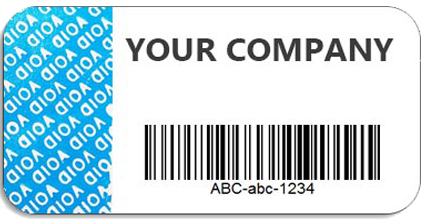Table of Contents
ToggleIntroduction
When it comes to asset tracking, durability matters. Poly asset labels, made from strong polyester material, offer long-lasting performance in demanding environments. These labels are ideal for businesses that need clear, reliable identification of tools, equipment, IT devices, and inventory—indoors or outdoors.
In this blog post, we’ll explain what poly asset labels are, how they work, where to use them, and how you can personalise them with barcodes, QR codes, and other custom features. We’ll also show how they compare to other label types like paper and vinyl, and why they’re a top choice for long-term asset management.
What Are Poly Asset Labels?
Poly asset labels are high-performance tags made from polyester (often referred to as PET). Polyester is chosen for its toughness, weather resistance, and print clarity. These labels are designed to stick permanently to a range of surfaces and hold up against water, heat, chemicals, and daily wear.
Each label has several layers:
Polyester face stock — Provides durability and a crisp surface for printing
Printed layer — Your design, asset number, barcode, or branding
Adhesive backing — Strong permanent adhesive for secure bonding
Release liner — Peel-away backing for easy application
Poly asset labels are thin, flexible, and made to survive in industrial, warehouse, and office environments.
Why Use Polyester Over Paper or Vinyl?
| Feature | Polyester (PET) | Paper | Vinyl |
|---|---|---|---|
| Durability | High | Low | Medium |
| Water Resistance | Excellent | Poor | Good |
| Tear Resistance | Excellent | Poor | Medium |
| Print Clarity | High | Medium | Medium |
| UV/Outdoor Suitability | Excellent | Poor | Good |
| Adhesive Strength | Permanent (strong) | Varies | Varies |
Poly asset labels outperform paper and vinyl for longevity and durability, especially in tough or outdoor conditions.
Key Benefits of Poly Asset Labels
Waterproof and UV-resistant — Built for indoor and outdoor use
Chemical-resistant — Withstands cleaning agents and oils
Tearproof — Maintains shape and integrity over time
Long-lasting adhesive — Bonds well to plastic, metal, and painted surfaces
Customisable — Includes barcodes, QR codes, logos, and more
These labels are made for businesses that need dependable asset tracking that won’t fade, peel, or smudge.

Where to Use Poly Asset Labels
These labels are incredibly versatile. Some popular uses include:
IT & office equipment — Tagging laptops, printers, docking stations
Tools and machinery — Heavy-duty labeling for equipment or hand tools
Warehousing — Shelf markers, bin labels, pallet tracking
Retail — Product tracking, stock audits
Healthcare — Sterilisation-resistant labels for medical devices
Personalisation Options
Polyester asset labels can be customised in many ways to suit your operations:
1. Barcodes
Quick and easy scanning
Works with asset management software
Supports formats like Code 128, Code 39, EAN, and more
2. QR Codes
Can link to webpages, asset records, or service history
Scannable with smartphones
3. Serial Numbers
Each asset gets a unique ID
Helps track usage, location, or status
4. Company Branding
Add logos, slogans, or color codes
Helps reinforce brand and visual identity
5. Variable Data Printing
Add dynamic fields like department, user name, or custom instructions
6. Shapes and Sizes
Choose the layout that fits your asset type—from small tools to large equipment
With the right customisation, your poly asset labels become more than just ID tags—they become key tools in your asset control process.
How Are Poly Labels Printed?
These labels are usually printed using thermal transfer technology for crisp, high-resolution output. This method ensures long-lasting, smudge-free text and codes. The ribbon used in printing bonds permanently to the polyester surface, making the labels ideal for years of use.
Printing can be done in bulk, with sequential serial numbers or unique QR codes. You can also choose colour printing for more advanced designs.
Best Practices for Applying Poly Labels
For best results:
Clean the surface before applying (remove dust, oil, or residue)
Apply with firm pressure
Let the adhesive cure for 24 hours for maximum bond strength
Avoid placing on rough or uneven surfaces unless labels are specially cut for it
Final Thoughts
If your business relies on reliable asset tracking, poly asset labels are a smart investment. They’re durable, customizable, and suitable for tough conditions. Whether you’re tagging laptops in an office or machinery on a job site, these labels provide a permanent, professional solution.
With options for barcodes, QR codes, serial numbers, and full branding, poly labels help you track smarter, not harder.
